The Best Demand Planning Software
Demand planning software is essential for optimizing inventory for complex retail, manufacturing, and distribution supply chains. We reviewed the top solutions that enhance stock accuracy and manage supplier lead times.
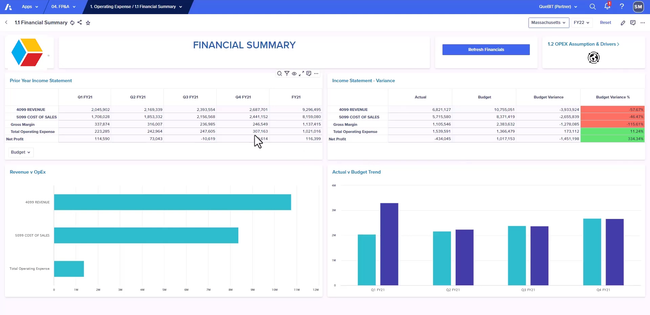
- Connected Planning platform enables collaborative planning
- Hyperblock™ modeling and calculation engine
- Unified cloud-based software

- Cloud-based software is accessible anytime, anywhere
- Real-time detection of stockouts and overstock risk
- Data driven forecasting of new products
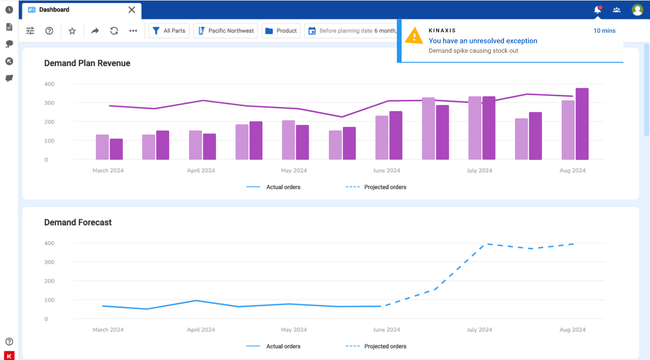
- Effective constraint planning
- Intuitive user interface
- Customizable dashboards, alerts, and exceptions
Demand planning software can leverage the power of AI and machine learning to help businesses forecast demand accurately, plan inventory effectively, and make informed decisions. We used our advanced review methodology to evaluate top solutions for small, medium, and enterprise-level businesses across all industries.
- Anaplan: Best AI-Driven Analytics
- Intuendi: Best for Distributors
- Kinaxis: Best “What-if” Scenario Planning
- e2open: Best for Demand Sensing
- Logility: Best for Manufacturing
- RELEX: Best for Retail
- Netstock: Best Integration Options
- SAP Integrated Business Planning: Best Product Ecosystem
- Blue Ridge: Best for Replenishment Planning
- Avercast: Best Customization Options
Anaplan - Best AI-Driven Analytics
Anaplan’s advanced analytics and AI tools can help you improve your decision-making through data-driven insights and predictive modeling. This functionality uses historical data to identify patterns and trends, which are used to forecast future demand with high accuracy.
You can utilize this capability to help prepare for surges. For example, historical insights might show an uptick in demand for specific products during winter; however, this year, external data indicates that there will be a harsher-than-normal winter in key regions. Anaplan’s AI models can factor in demand spikes for winter apparel and potential shipment delays from snowstorms, which minimizes your risk of stock-outs during peak season.
As the season approaches, the system will make adjustments to demand in real-time. It can detect unexpected demand for certain products and automatically alert you. Anaplan recommends redistributing stock from slower-moving regions to high-demand areas, helping minimize lost sales. With these insights, you can efficiently avoid overstocking low performers and meet customer demand.
On the financial side, Anaplan’s Finance Analyst AI agent scans your forecasts and budgets for possible revenue shifts and cost overruns. The agent then pinpoints the underlying causes and summarizes the financial impact for you. It can also assess response scenarios, like pricing or stock adjustments, and show how each option will impact your bottom line and service levels.
Intuendi - Best for Distributors
Intuendi’s smart visualization tools help distributors manage hundreds of SKUs across regions, channels, and fulfillment centers. Intuitive, graphical dashboards make digesting demand trends and inventory positions easy, vital for staying ahead of margin pressure and stock volatility.
Your planners can open a high-level view of expected demand across the entire catalog, comparing unit volumes and revenue expectations at a glance. They can filter by warehouse, sales segment, and item group to spot underperforming regions or fast-moving lines. If a marketing campaign causes a sudden demand spike in one area, Intuendi flags the anomaly on a time-series chart and shows confidence intervals that depict data reliability.
Your planners can switch to SKU-level analysis for priority items. Live inventory visuals overlay current stock positions with projected depletion rates, reorder points, and lead time coverage. Planners can simulate risk as well, overriding Intuendi’s projections with local insights. For example, planners can bump a forecast from 1,200 units to 1,800 for an upcoming campaign. Intuendi then displays the models side by side, so they can easily see the revenue difference, track the impact, and adjust course.
Pricing starts at roughly $1,600/month, though this varies based on the exact feature set you need. Adding more than five users can increase the cost; more users contribute to more inputs and data, which in turn makes the AI models more complex to run.
Kinaxis - Best “What-if” Scenario Planning
What-if scenario planning in Kinaxis Maestro allows you to run simulations directly from real-time operational data. You can clone a live plan and model disruptions, such as a manufacturing plant shutdown. This helps you see how that change ripples through customer demand and fulfillment, showing whether orders can still be met and at what cost to service or revenue levels.
Once activated, each simulation appears on an interactive network map that links distribution and manufacturing nodes. As conditions shift, color-coded nodes turn from green to red to flag late allocations and bottlenecks. You can click into any site to view the quantitative impact, from late orders to constraint utilization. From there, it’s easy to toggle between scenarios to compare sourcing or transfer strategies.
Maestro’s comparative analytics view displays each option in hard business metrics, including revenue, margin, on-time-to-request, and inventory. For example, a live plan might deliver 100% on-time performance, while a shutdown scenario drops to 83.9%, reducing your overall score to 73%.
Unlike other demand planning platforms that rely on manual data refreshes, Maestro runs every scenario on the same concurrent planning engine that powers daily operations. Every scenario reflects real-time supply, demand, and logistics data, which makes modeling faster and more actionable. However, this level of precision comes with complexity; smaller companies with fewer resources might find Maestro’s sophistication is more than they need.
e2open - Best for Demand Sensing
e2open platform excels in demand sensing, creating highly accurate short-term demand forecasts. To predict future trends, it can measure demand signals, including social media sentiment, stock levels, current sales, and competitor prices. This enables you to leverage internal datasets with external data from suppliers and partners to analyze the current market and make changes as the market moves.
Because e2open can pull data from sources such as an internal POS and current competitor promotions, businesses have seen an increase in the accuracy of demand forecasts by 30-40% compared to traditional methods. However, businesses looking for a more modern interface might find e2open lacking as users have found its archaic look and feel outdated.
Logility - Best for Manufacturing
Logility offers an AI-assisted demand planning module, InventoryAI+, to help you manage manufacturing supply chains. Logility features planning and scheduling functionality integrated directly within their system, while other solutions require a third-party integration to capture those same features.
Logility’s InventoryAI+ module considers and plans for work-in-progress, raw materials, components, and subassemblies, which is helpful for complex manufacturing operations.
RELEX - Best for Retail
RELEX is a suitable solution for retailers as it improves shelf space, reduces stockouts, and increases sales. One of the RELEX platform’s strengths is the ability to run locally optimized planograms across multiple store locations simultaneously. This helps match daily replenishment schedules and demand, ensuring more goods fit on the shelf and reducing excess stock in the backroom.
Additionally, RELEX has a history of experience working with retailers. In 2022, CORA France used RELEX to reduce its in-store inventory by 5% across 63 locations by automating the replenishment of their products.
Netstock - Best Integration Options
Netstock offers an extensive list of ERP integrations. Out of the box, Netstock integrates a broad spectrum of ERP solutions such as NetSuite, Sage 300, Sage X3, SYSPRO, Acumatica, Microsoft Dynamics 365, and many others.
This allows manufacturers, distributors, and retail operations of any size to use the Netstock platform without disrupting existing processes.
SAP Integrated Business Planning - Best Product Ecosystem
SAP IBP provides an integrated demand planning platform for businesses using existing SAP products. It offers native integration with SAP S/4HANA and S4HANA Manufacturing to improve supply chain visibility and collaboration across departments.
However, businesses looking for an end-to-end solution or are not already using SAP, may run into integration issues or require the purchase of additional products such as the SAP Analytics Cloud.
Blue Ridge - Best for Replenishment Planning
Blue Ridge offers an effective inventory replenishment planning module that includes automated workflows. It incorporates real-time sales and supply chain data and inputs it into advanced algorithms for more accurate replenishment forecasting. This can help you maintain optimal stock levels, reducing overstock and out-of-stock rates.
The module also helps streamline the purchasing process using AI and machine algorithms within the replenishment module. This considers important factors like long lead times, fluctuating demand, and historical data to get purchase orders to suppliers on time. This is noteworthy compared to other systems, as it better enhances purchasing for specialized businesses with complex supplier relationships. For example, metal fabricators may experience long lead times due to the specialized nature of materials, thus requiring precise replenishment forecasting to ensure timely purchasing.
Additionally, your company can better optimize the order cycle for each supplier. The system automatically evaluates acquisition and carrying costs for the entire inventory, frequency of purchases from suppliers, and supplier constraints. Combining these variables, you can determine each supplier’s least costly order cycle, which drives profitability by lowering inventory investment company-wide.
Avercast - Best Customization Options
The Avercast platform offers 280+ custom AI-powered algorithms configured to your unique business needs. The system works one-on-one with every customer to tailor custom screens, workflows, and functions.
While Avercast is highly customizable for each customer’s individual needs, upgrading to a newer version requires users to reconfigure their forecasts, and some have found the older SQL-style menus cumbersome.
What Is Demand Planning Software?
Demand planning and forecasting software is a sales and operations planning (S&OP) technology that meets customer demand with the necessary supply level. This is accomplished by coordinating data from separate business units (primarily sales, marketing, and operations) to make more informed supply chain planning decisions that directly relate to inventory optimization.
Accurate demand planning involves collecting historical data on order volumes and inventory turns while mixing it with continually updated forecasts from your sales personnel.
Demand Planning Software vs. Business Intelligence Software
Demand planning solutions can be considered a business intelligence software specifically for supply chain analytics. The software can estimate future sales to improve inventory management and replenishment accuracy, plan purchases, and ensure proper stocking levels.
Demand planning software aims to manage your supply chain more effectively to increase inventory turns and fill rates beyond what your ERP suite or supply chain management software can do.
Key Features
| Feature | Description |
|---|---|
| Sales and Operations Planning (S&OP) | The overall management of your sales plan and operations plan, which includes tracking sales per month by product family, demand management (such as new product promotions and special offers), production per month by product tracking, workforce and inventory level tracking, and backorder management |
| Demand Planning | Forecast demand for a product so it can be developed and shipped in as efficient as possible ways |
| Inventory Planning | Identify non-performing inventory SKUs and avoid overstocking. Scale for error to ensure under and over-forecasting situations even each other out. |
| Supplier Management | Helps strategically plan and manage interactions with any vendors or suppliers of goods. Set reminders for reorders and reduce risk in your supply chain. |
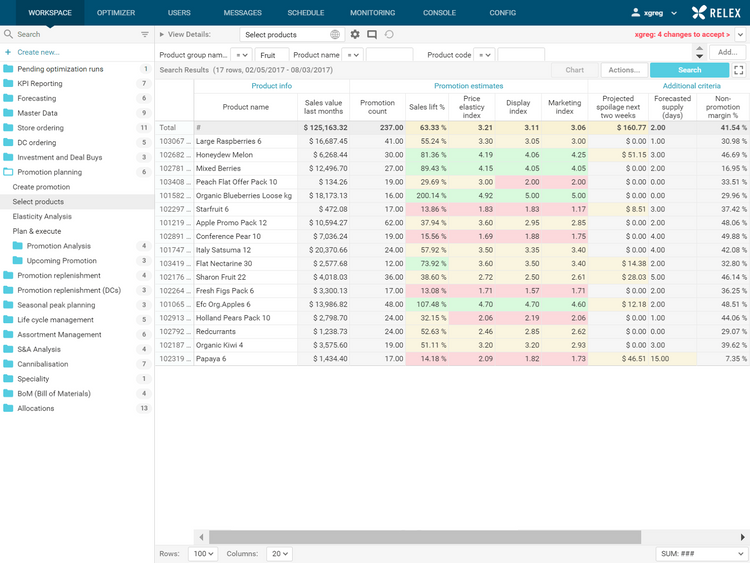
Benefits
Improve Sales and Operations Planning
The sales and operations planning process helps companies create plans to maintain current business and take on new customers with new products through proper supply chain management. The process can help merge insight from all departments (such as sales, marketing, manufacturing, and more) to create an all-inclusive business plan to balance supply and demand. Execution between these departments centered around sales forecasts ensures that goods flowing through your supply chain are as optimized as possible.
A business will want to conduct the sales and operations planning process each month in various phases. This includes moving along the following processes:
- Sales forecasting: This is the generation of historical data (past sales) to analyze trends and create proper expectations (demand forecasts)
- Demand Planning: What are your current sales? What did your business forecast? Now, what did your business plan for? Demand planning in the sales and operations planning process is about validating your forecasts. Where does your demand typically come from? You’ll need to account for variability and adjust your inventory structure to account for it (if any).
- Supply Planning: Your business must ensure your production levels are as close as possible to what you previously planned for (via demand planning). This step is about assessing your ability to meet demand by reviewing available capacity and scheduling your production/output to the necessary level.
- Reconciliation of plans: This stage will help balance your demand and supply with any financial considerations and ensure that the previous steps have been accounted for.
- Finalize and link to the implementation: The execution stage of the process and the final step in the sales and operations planning process. Usually, for larger (global) companies, the process is put into place and funnels down to regional supplies (depending on if the operation produces items globally or sold and produced at a regional level)
Optimize Inventory
To ensure proper inventory levels are in place to meet your demand, you need proper inventory optimization. Inventory optimization software automates the analyses of your entire inventory cycle.
An optimized inventory optimization solution will examine the differences between demand forecasts and historical sales data to determine appropriate stocking levels. An incorrect forecast can lead to your business being unable to meet demand, which leads to products sitting idle, or even worse, you can’t fulfill sales orders on time.
Effective demand planning software will lead to your inventory being at its most optimal level by creating multiple what-if scenarios. This includes analyzing all parts of your supply chain, such as sourcing, production, warehousing, and transportation.
How does one change affect the other? What sort of impact does each change have on various types of inventory? Since inventory optimization can be seen as a form of predictive analytics, demand planning systems will accurately predict the amount and type of stock to carry.
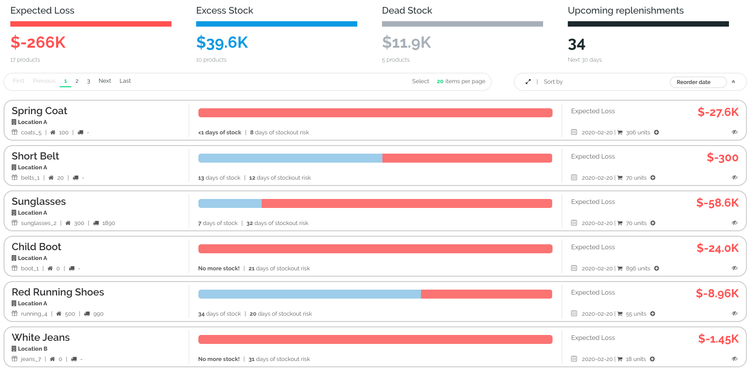
Optimize Labor Management
Demand planning software can also plan for labor demand rather than inventory optimization. This type of demand planning will accurately determine the number of workers available, which can influence costs and the quality of service provided to customers. The end goal of labor management via demand planning software will be to drive employee engagement and performance to enhance business results.
Workload analysis capabilities allow decision-makers to determine the standard time to produce a unit. This is opposed to a traditional and more subjective method of estimating the number of employees required for upcoming production periods.
By using workload analysis, you can determine the estimated number of workers by dividing the estimated number of hours needed to meet annual production by the workability of your workers.
Workers can also be incentivized to perform well on the job. Establishing benchmarks can maximize workforce potential by recognizing good performances. Conversely, it gives you visibility into completed tasks and any employee downtime.
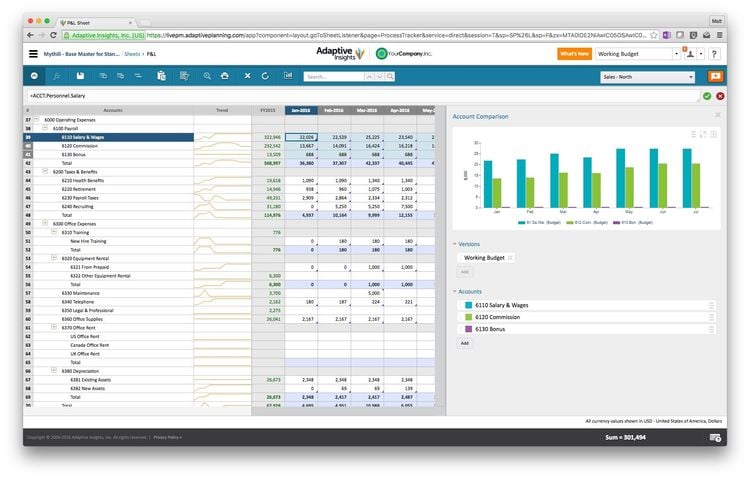
Integrated Cash Flow Management
By including financials in your sales and operations planning processes, your entire organization will better understand the data and how it can help plan and shape your financial goals. This includes planning capital projects effectively and scheduling maintenance repairs efficiently—all while knowing how it affects your bottom line.
Demand planning software can also improve cash flow by providing insight into how current inventory impacts finance. Too much inventory can disrupt cash flow–leaving you unable to meet demand.
By forecasting financials along with demand, you’ll be able to have a more sophisticated budgeting process. Depending on how far ahead into the future you forecast, you’ll be able to use financial projections based on projected demand when creating budgets or speaking to executives and decision-makers–giving you increased credibility with stakeholders.
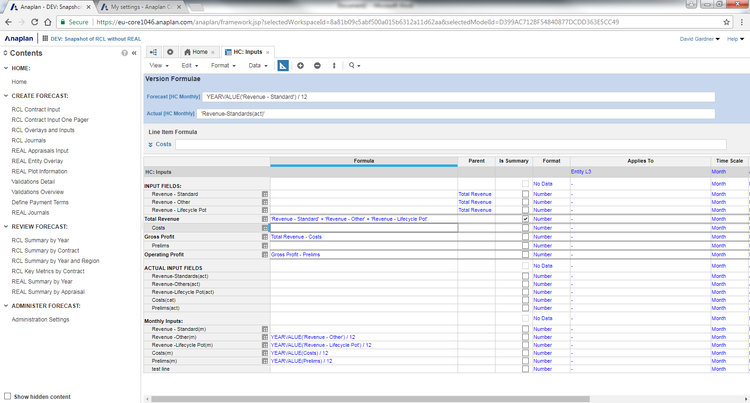
Types of Demand Forecasting Methods
Demand is the biggest factor in creating sales forecasts, so you’ll want to make sure you use the most appropriate type of demand forecasting for the products you manufacture, the market you’re involved with, the staff you have on hand, and more.
Most demand planning and scheduling software will use predictive analytics capabilities to determine how scheduling, production, inventory, and staffing should be allocated for production. However, there are other methods of demand planning to consider:
Delphi Method
Known as one of the more time-consuming demand planning methods, the Delphi Method surveys experts anonymously. The surveys are administered in multiple rounds of questions, each new question being generated based on the summary of results received thus far.
The Delphi Method aims to get these experts to arrive at a consensus opinion. In the supply chain process, this consensus opinion is used in development to ideate new products, which can affect the inventory kept on hand.
Conjoint Analysis
This survey-based statistical technique considers perceived value and relies heavily on asking customers what they want. This is more of a judgemental approach to demand planning, as the survey planners (the forecasters) will ask the participants to make trade-offs when conflicts arise.
If customers want product A, will they take product B with similar benefits/features? In a supply chain, conjoin analysis helps businesses determine the importance of a product’s attributes and price. This can let businesses shift the features offered or adjust pricing to hit certain benchmarks in their overall sales. It can also let them know when a customer may consider buying a competitor’s product over theirs.
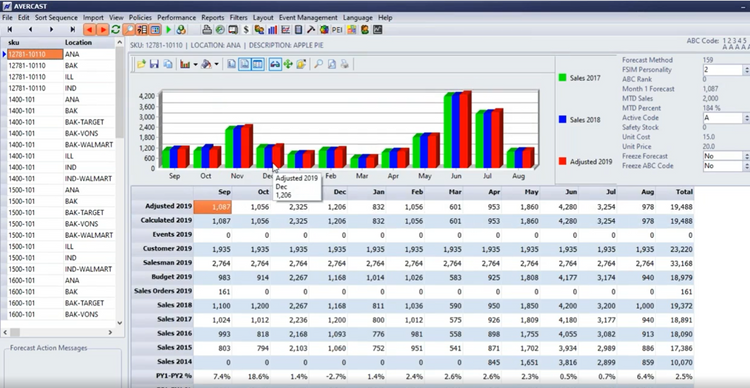
Demand Planning vs Supply Planning
The difference between demand and supply planning is that demand planning forecasts customer demand, while supply planning manages inventory to meet this demand.
Demand planners use extensive data, including past sales, to produce both constrained and unconstrained demand forecasts, indicating potential demand with and without limitations. These forecasts help businesses manage orders efficiently and reduce inventory costs.
Supply planning aims to efficiently fulfill demand forecasts, focusing on manufacturing lead times, order quantities, production leveling, and safety stocks. It operates based on the demand plan, which generates a master production schedule. The supply plan then assesses capacity and resource impact, making necessary adjustments.
Read more: Demand Planning vs Supply Planning: What are the Differences?
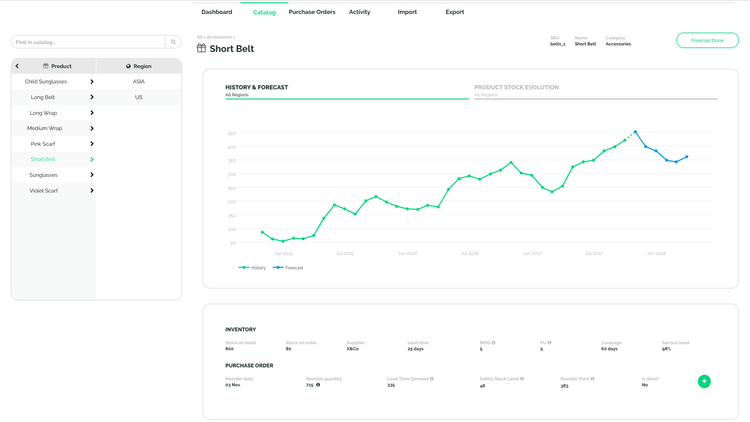
Trends in Demand Planning Software
- AI and Machine Learning Integration: Demand planning software incorporates AI and ML to analyze large datasets, identify patterns, and make accurate predictions. This capability enhances forecast accuracy and helps you respond quickly to market changes.
- Collaborative Planning, Forecasting, and Replenishment (CPFR): These tools allow you to share data in real-time with members from different departments in your business. This capability helps align your production strategies and reduce any miscommunication.
- Omni-channel Integration: Demand planning software accounts for customer needs across multiple channels, including retail stores, eCommerce, and wholesale. This integration can help you maximize operational efficiency and profitability.
Pricing Guide
Demand planning software pricing can range from $10,000 to over $200,000/year.
| Tier | Company Size | TCO | Example Solutions |
|---|---|---|---|
| Low Tier | 1–10 employees | $10K – $25K per year | Katana MRP |
| Mid Tier | 10–50 employees | $25K – $75K per year | Intuendi, Relex (SMB package) |
| High Tier | 50–200 employees | $75K – $200K per year | Blue Ridge, o9 Solutions |
| Enterprise | 200+ employees | $200K+ per year | Kinaxis |
Setup or implementation fees vary even more widely, from $30,000 to over $100,000. The specific pricing may depend on factors such as organization size, the complexity of the demand planning processes, and the level of customization required.



















































